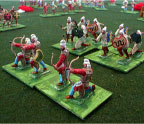 Version
2: This is the second
version of the Battle of Marathon Rules. The original version
can be found here. The rules have
not been changed. New battle reports and pictures were added,
and the order of battle was revised.
Version
2: This is the second
version of the Battle of Marathon Rules. The original version
can be found here. The rules have
not been changed. New battle reports and pictures were added,
and the order of battle was revised.
 Version
2: This is the second
version of the Battle of Marathon Rules. The original version
can be found here. The rules have
not been changed. New battle reports and pictures were added,
and the order of battle was revised.
Version
2: This is the second
version of the Battle of Marathon Rules. The original version
can be found here. The rules have
not been changed. New battle reports and pictures were added,
and the order of battle was revised.
Historical Background: The mighty Persian Empire was more than a little annoyed when the Greeks encouraged the Ionians to revolt. After crushing the revolt King Darius decided to punish the upstarts. In 490 BC he led an army of over 40,000 soldiers into Greece. There they faced a force of 10,000 Athenians on the plains of Marathon. The Athenians surprised the Persians by charging them. The strategy worked, and they routed the much larger force, driving them into the sea. This battle was recreated twice for my students in grades 6 - 8. It was a good choice for the first battle of the school year since it was strictly an infantry fight.
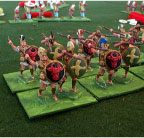 Battle
1: As the Greek hoplites
rapidly approached the Persian lines they were targeted by accurate
and effective fire from the Persian skirmishers. On the Persian
left flank King Darius personally directed the fire, to devastating
effect. Finally the Greeks reached the enemy and charged, turning
the tide of battle. The Persian skirmishers were quickly scattered.
Darius ordered some of his elite Immortals to reinforce the center.
They stemmed the tide, but suffered terrible casualties. A small
group of Greek archers took up a position near the center of the
battlefield where they became a real nuisance, harassing the Persian
heavy infantry at every opportunity. A frustrated Persian commander
ordered his infantry to turn their bows on the Greek skirmishers,
and the Greeks were buried under an avalanche of arrows. On the
Greek right flank a small group of infantry were cut off and surrounded
by the Persians. The Persian commander demanded their surrender,
but they vowed to "die like Spartans." Big talk coming
from a bunch of Athenians. But they were true to their word, and
the Persians were forced to detach a large infantry force to finish
off the stubborn Greeks. As the battle neared its end the Persians
sent in the last of their Immortals. They drove into enemy with
ferocity before being cut down by the Greeks. In the end the Persians
sent in the last of their fresh reserves, and this proved decisive.
The Persian had won the battle, but at terrible cost. Darius had
lost the heart of his army. He issued orders for his men to withdrawal
to their ships. The invasion of Greece was ended, and Athens was
saved.
Battle
1: As the Greek hoplites
rapidly approached the Persian lines they were targeted by accurate
and effective fire from the Persian skirmishers. On the Persian
left flank King Darius personally directed the fire, to devastating
effect. Finally the Greeks reached the enemy and charged, turning
the tide of battle. The Persian skirmishers were quickly scattered.
Darius ordered some of his elite Immortals to reinforce the center.
They stemmed the tide, but suffered terrible casualties. A small
group of Greek archers took up a position near the center of the
battlefield where they became a real nuisance, harassing the Persian
heavy infantry at every opportunity. A frustrated Persian commander
ordered his infantry to turn their bows on the Greek skirmishers,
and the Greeks were buried under an avalanche of arrows. On the
Greek right flank a small group of infantry were cut off and surrounded
by the Persians. The Persian commander demanded their surrender,
but they vowed to "die like Spartans." Big talk coming
from a bunch of Athenians. But they were true to their word, and
the Persians were forced to detach a large infantry force to finish
off the stubborn Greeks. As the battle neared its end the Persians
sent in the last of their Immortals. They drove into enemy with
ferocity before being cut down by the Greeks. In the end the Persians
sent in the last of their fresh reserves, and this proved decisive.
The Persian had won the battle, but at terrible cost. Darius had
lost the heart of his army. He issued orders for his men to withdrawal
to their ships. The invasion of Greece was ended, and Athens was
saved.
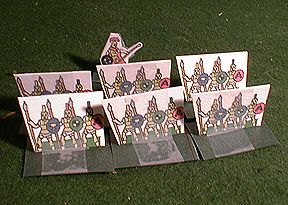 Battle
2: The second battle was
an interesting contrast in strategies. The Greek commanders wanted
to close with the enemy as quickly as possible so they could take
advantage of their superior infantry in close combat. The Persians
wanted to delay this confrontation so could exploit their edge
in archery. The Greeks rushed forward behind a screen of skirmishers,
and the Persian skirmishers kept up a deadly barrage while retreating.
Finally the frustrated Greek commanders sent their infantry ahead
of their own skirmishers to drive off the Persian archers. Their
depleted battalions forced their way past the Persian screen and
came to grips with the enemy infantry. Savage fighting broke out
all across the battlefield as the combatants settled their grudge
with spears and shields. On the Persian left an astute commander
made quick work of his Greek adversary. On the Persian right the
tables were turned, and the Greeks gained the advantage. Slowly
the Greek attack lost steam, and the Persians pushed them back.
The Persians won a close fought but decisive victory and succeeded
in changing history. A triumphant Darius ordered his men to get
some rest and be ready to march on Athens in the morning.
Battle
2: The second battle was
an interesting contrast in strategies. The Greek commanders wanted
to close with the enemy as quickly as possible so they could take
advantage of their superior infantry in close combat. The Persians
wanted to delay this confrontation so could exploit their edge
in archery. The Greeks rushed forward behind a screen of skirmishers,
and the Persian skirmishers kept up a deadly barrage while retreating.
Finally the frustrated Greek commanders sent their infantry ahead
of their own skirmishers to drive off the Persian archers. Their
depleted battalions forced their way past the Persian screen and
came to grips with the enemy infantry. Savage fighting broke out
all across the battlefield as the combatants settled their grudge
with spears and shields. On the Persian left an astute commander
made quick work of his Greek adversary. On the Persian right the
tables were turned, and the Greeks gained the advantage. Slowly
the Greek attack lost steam, and the Persians pushed them back.
The Persians won a close fought but decisive victory and succeeded
in changing history. A triumphant Darius ordered his men to get
some rest and be ready to march on Athens in the morning.
Rules
The Armies: The Greek and Persian armies were built from the Italieri sets of 1/72 scale plastic figures (5 boxes of each) mounted two per base (1.5" X 1"). Skirmishers were in single rank lines (3-6 stands), and formed infantry were in double rank lines (6-10 stands). There were five Generals on each side. Some of the Greek javelin skirmishers were used on the Persian side. All Persians except the javelin and sling skirmishers are assumed to have bows. Persians with large rectangular shields were classified as heavy infantry, and ten stands of these were Immortals. Persians holding bows, slings, or javelins were treated as skirmishers, all the rest were regular infantry. All Greek infantry were treated the same except for their skirmishers (figures with slings, javelins, or bows). Here are some paper soldiers you can print and use.
|
Greek 5 Commanders 13 units Infantry (6 bases each) 2 units Javelin Skirmishers (3 bases each) 4 Archer Skirmishers (3 bases each) 2 Sling Skirmishers (3 bases each) |
Persians 5 Commanders 2 units Immortals (5 bases each) 4 units Heavy Infantry (6 bases each) 4 units Regular Infantry (6 bases each) 8 units Javelin Skirmishers (3 bases each) 8 units Archer Skirmishers (3 bases each) |
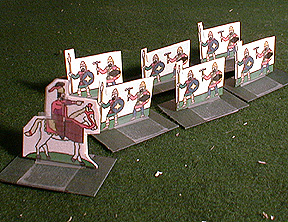 The
Board: The battle was
played on a flat 7.5 X 5 table. The armies were deployed about
18" apart.
The
Board: The battle was
played on a flat 7.5 X 5 table. The armies were deployed about
18" apart.
Sequence of Play:
1. Greeks Move
2. Greeks Shoot
3. Persians Move
4. Persians Shoot
5. Charge into Melee
6. Melee
Movement: All units move 6". On turn one any Greek unit may make a double move. Skirmish units may move in any direction. Formed units are limited to wheels and obliques of 45 degrees.
Shooting: Skirmishers and formed Persian infantry are allowed to shoot. Roll 1D6 for each stand in range. Every 6 is a hit and one enemy stand is removed. If any part of a unit is in range the entire unit may fire. Units that are engaged in melee may not fire, and may not be targeted.
Charge into Melee: Both sides may charge into melee. This is the only way to get into hand-to-hand fighting. Units may charge up to 6", but may only move if they can reach an enemy unit.
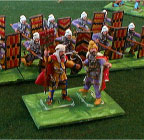 Melee: Each side rolls 1D6 for each stand in
the fight. The Close Combat table shows the number needed to score
hits. Remove one enemy stand for every hit. Both sides roll simultaneously.
If both units still have stands left they remain engaged and fight
again next turn.
Melee: Each side rolls 1D6 for each stand in
the fight. The Close Combat table shows the number needed to score
hits. Remove one enemy stand for every hit. Both sides roll simultaneously.
If both units still have stands left they remain engaged and fight
again next turn.
Last Stand: If a unit is reduced to one stand this last stand is removed immediately.
Generals: Generals may not be targeted individually. If they are attached to a unit they count as an extra stand in melee (but not shooting). If the unit they are attached to loses stands in melee roll 1D6. If the roll is a 6 then the General is eliminated.
|
|
|
Resources